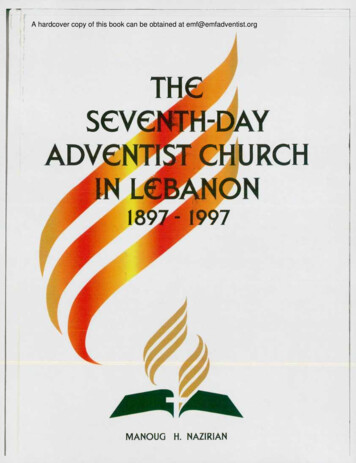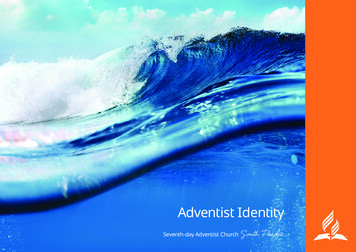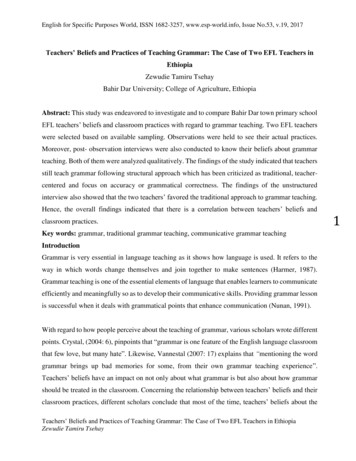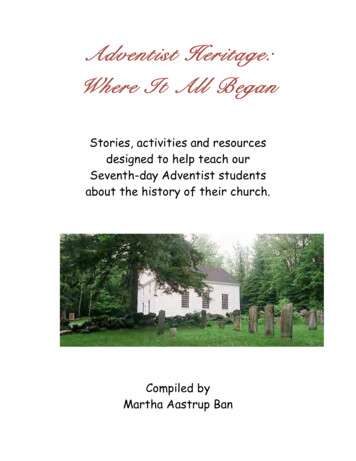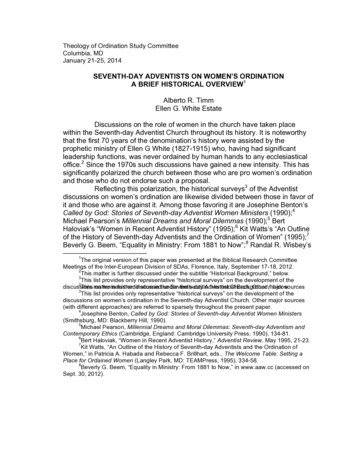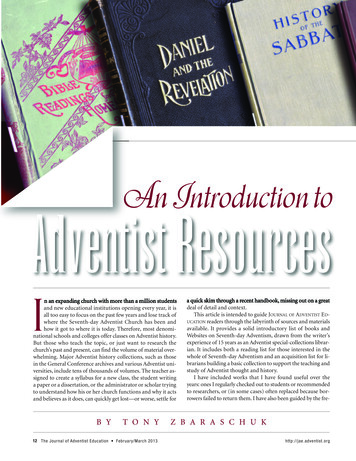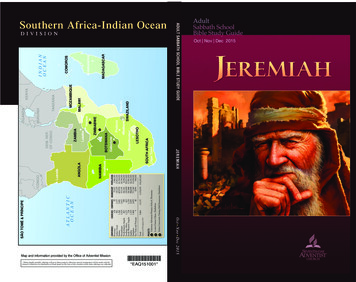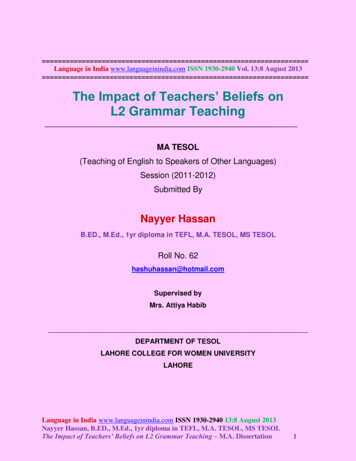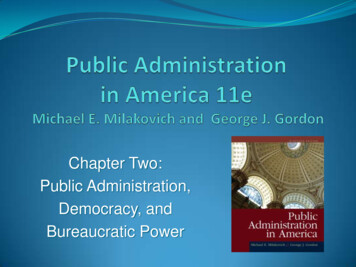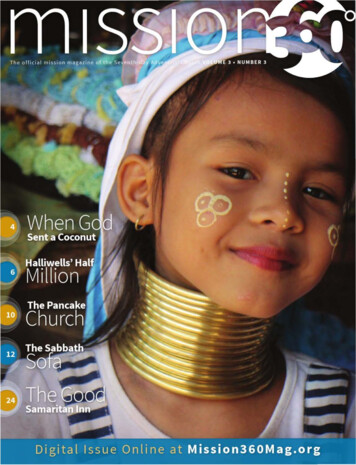
Transcription
Contemporary Contextof the Adventist MissionJob Descriptionof the GC PresidentChanges to the Statementof 28 Fundamental BeliefsAdventistS U M M E R 2 0 1 5 W W W . A T O D AY. O R GTodaySan Antonio2015 GENERALCONFERENCESPECIALISSUE
I N S I D E VO L . 23 N O. 3AdventistTodayEditorfeatures4 T he Beautiful Importanceof PluralismBy Smuts Van Rooyen8 T hat’s So Meta: ThePost-Postmodern ChurchBy Tom de Bruin14 H ow Adventists ChooseTheir LeadersBy Reinder Bruinsma19 R ules of Order at a GeneralConference SessionBy Gary Patterson21 Q uestions That Needto Be AskedBy Gary Patterson24 Job Description fora PresidentBy Gary Patterson28 Spirit-Driven Leadership Throughthe Lens of Ellen G. WhiteBy Cindy Tutsch32 “Circumstances Alter Cases”and the Ordination of WomenBy Jon Paulien38 The Road to San Antonio—and BeyondBy Alden ThompsonJ. David NewmanExecutive EditorMonte SahlinCopy EditorDebra J. HicksContributing Editors42 Proposed Changes to the28 Fundamental BeliefsBy Adventist Today staff42 Adventists Voice ConcernsAbout Changing Our CreationStatementBy Adventist Today staff48 Genesis 1-11—A Different GenreBy Desmond Ford52 Freeing the First Angel andReopening the Doors ofAdventismBy Jack Hoehn53 How Does the Hierarchy DecideWhen It’s OK to Ignore the Bible?By Richard W. Coffen56 Global Mission of theAdventist MovementBy Jack SequeiraDEPARTMENTS3 EditorialWhat Will Happen at General Conference?By Monte Sahlin60 Alden ThompsonExodus 3-4: “Oh Lord, Send Someone Else”63 Adventist ManIggy’s Great IdeaAdventist Today brings contemporary issues of importance to Adventist church members and is a member of The Associated Church Press. Following basicprinciples of ethics and canons of journalism, this publication strives for fairness, candor, and good taste. Unsolicited submissions are encouraged. Paymentis competitive. Send an email to atoday@atoday.org or mail to: Adventist Today, PO Box 1135, Sandy, OR 97055-1135. Voice: (503) 826-8600 Website: atoday.org.As an independent press, Adventist Today relies on donations to meet its operating expenses. To make a donation, go to www.atoday.org or mail to AdventistToday, PO Box 1135, Sandy, OR 97055-1135. Thanks for supporting Adventist Today with your regular tax-deductible donations.Adventist Today (ISSN 1079-5499) is published quarterly by Adventist Today Foundation, 50800 SE Baty Rd, Sandy, OR 97055. Annual subscriptions 29.50( 50/2 years) for individuals. 40 for institutions. (Payment by check or credit card.) Add 10 for address outside North America. Periodical postage paid atSandy, Oregon, and at additional mailing offices. POSTMASTER: Send address changes to Adventist Today, P.O. Box 1135, Sandy, OR 97055-1135. Copyright 2015by Adventist Today Foundation, a nonprofit organization dedicated to fostering open dialogue in the Adventist community.2ADVENTIST TODAY SUMMER 2015James WaltersJohn McLartyArt DirectorChris KomisarOnline EditorsManaging Editor: Jeff BoydFeatures: Debbonnaire KovacsOpinion: Mark GutmanPoetry and the Arts: Debbonnaire KovacsReviews: Edwin A. SchwisowWeb Coordinator: Heather GutmanFacebook Editor: Emmy HalvorsenExecutive DirectorMonte SahlinExecutive Secretary of DevelopmentEdwin A. SchwisowF O U N D AT I O N B O A R DNate Schilt, Jim Walters, Monte Sahlin, AndrewClark, Keith Colburn, Chris Daley, Larry Downing,John Hoehn, Edmond Jones, Mailen Kootsey, KeishaMcKenzie, Chuck Mitchell, Jim Nelson, WarrenNelson, Chris Oberg, Gene Platt, E. Gary Raines, PaulRichardson, Sasha Ross, Dan Savino, J. Gordon Short,James Stirling, Eldon Stratton, Ervin Taylor,David Van Putten, John VogtSENIOR LIFETIME ADVISORS( 25,000 )Elwin Dunn, Patricia and Douglas Ewing, Kathi andRichard Guth, John Hoehn, Judy and John Jacobson,Al Koppel, Joan Ogden, Lori and Thaine Price, Judyand Gordon Rick, J. Gordon Short, Marilynn and ErvinTaylor, Nancy and John Vogt, Priscilla andJames WaltersL I F E T I M E A D V I S O R S ( 10,000 )Jane Bainum, Susan and Hernan Barros, Kelli andRobert Black, Ginny and Todd Burley, Pat and RonCople, Kathryn and James Dexter, Rosemary andMerlyn Duerksen, Dan Engeberg, Sandra and Sam Geli,Patricia Hare, Mariellyn and Edwin Hill, Carmen andClive Holland, Erika and Brian Johnson, Carmen andYung Lau, David T. Person II, Patricia Phillips, R. Marinaand E. Gary Raines, Judith Rausch, Stewart Shankel,James StirlingUNDERWRITING ADVISORS( 2,500 DURING THE LAST TWO YEARS)L. Humberto Covarrubias, William Garber, Dolores &Robert Hasse, Lucille Lorenz, Betty WebsterGENERAL ADVISORS( 500 /YEAR PLAN)Connie Anderson, W. L. Asher, M.D., Almon J. Balkins,Diana and Ken Bauer, Charlotte & Robert Brody, RuthChristensen and Glenn Henriksen, Beverly & SidneyChristiansen, Anders and Debra Engdahl, Ed Fry,William Garber, Karita & DeWitt Goulbourne, WayneGreaves, Jackie and Jim Henneberg, Lyndon Marter,Vincent Melashenko, Charles and Joan Mitchell, Gwen& Don Oliver, Michael and Corinne Pestes, ClaudiaPeterson, Marvin Ponder, Tracey & Craig Reynolds,Paul Richardson, Ruth and Beryl Rivers, Debi and E.Arthur Robertson, Gary Russell, Gretchen & MonteSahlin, Elmar Sakala, Beverly & David Sandquist,Dee Dee and Nate Schilt, Rebekah & Charles Scriven,Barbara and Eldon Stratton, Robert Tandy,Alden Thompson, Robin Vandermolen,Jackie and Hal Williams
E D I TO R I A LWhat Will Happen at General Conference?By Monte SahlinMany have said that the 2015 session of theGeneral Conference of Seventh-day Adventistsmay be a historic occasion. In preparation, wehave pulled together articles providing history,context, background on the major agendaitems, relevant Bible study, and counsel fromthe writings of Ellen G. White. We have tried toprovide a convenient, readable, and objectivepackage of information to prepare you for whatwill happen in San Antonio, Texas.Our international group of writers includes anumber of retired denominational leaders andwell-known scholars. There may be greater gifts ofwisdom and knowledge represented here than in anyissue of this journal published over the past quarterof a century. Donors gave Adventist Today the extrafunds necessary to make this a double issue, withtwice as many pages as usual, to make room for all ofthe important information they have provided. Weare also sharing a copy of this magazine with all ofthe General Conference (GC) Session delegates.The editors of this magazine, along with millionsof other Adventists, have been praying for God’swill to be done in this important meeting. We hopethat as you read the information in this issue, youwill reflect carefully and pray for wisdom in thedecisions you will be asked to make—whether youare a delegate or a denominational employee or amember in the pews—during or in the aftermath ofthis GC Session.The Adventist movement had less than a millionpeople when I was born in 1948. Today there areprobably 30 million when you include children tooyoung to be baptized, non-members who attendchurch and take Bible studies, and former memberswho have dropped out but still believe in the centraldoctrines of the Adventist faith. Along with growthin numbers, there has come much more complexdiversity. The context within which the missionof Christ is pursued has also changed. The core ofthe Adventist faith is the same, but the reality ofAdventist life today is different. With progress comesthe unanticipated, both good and bad.The item on the GC Session agenda that hasgenerated the most discussion in advance is thequestion about how ordination is to be handledrelative to women employed by the denominationas Seventh-day Adventist ministers. The GeneralConference Executive Committee referred thequestion to the delegates at the GC Session without arecommendation for or against. Now, six of the mostrespected retired leaders of the denomination havecome forward with their view on the question. (Seethe box on this page.)Adventist Today will work to keep you up-to-dateas news happens. Our sole mission is to provide anindependent, professional journalism service forAdventists around the world. We answer only to ourreaders. During the GC Session, wherever you arein the world, you can get immediate developmentsvia Twitter through @AdventistToday on yourSmartphone, tablet, computer, or other mobiledevice. At key times we will transmit developmentsliterally every few minutes.This specialGC Sessiondouble issuehas twice asmany pages asusual, to makeroom for all ofthe importantinformation itcontains.Why do these Adventist elders recommenda “Yes” vote at the GC Session?Elder Jan Paulsen, retired GC presidentElder Angel Rodriguez, retired director ofthe Biblical Research InstituteElder Charles Bradford, retired North American Division presidentElder William G. Johnsson, retired Adventist Review editorElder Alejandro Bullón, retired evangelist and ministerial secretaryElder Calvin B. Rock, retired GC vice presidentRead a brief statement from each of these men andothers at this website: www.adventistelders.comW W W. ATO DAY.O R G 3
FEATURETHE BEAUTIFULIMPORTANCEOF PLURALISMBy Smuts Van Rooyen4 ADVENTIST TODAY SUMMER 2015Not too long ago, my conference president put thischallenge to me as we were discussing church politics in the officeparking lot: “Show me what pluralism looks like. I don’t knowwhat it really is, nor how it is supposed to work in an Adventistcontext. Do you?”Fair enough. He was not hostile, just dubious. He caughtme off guard, which is not necessarily a bad thing. If I’d hadall of my wits about me, I would have said: “Pluralism lookslike a rainbow; it has diversity, a unified structure, and is fullof promise.” Nice sound bite, don’t you think? But it was nota quick-comeback day for me, so I mustered nothing of realvalue. To my credit, I knew what I should have said by the nextweek, or thereabouts.After some research (albeit limited), I have become more readyto address the topic and have gained a deeper appreciation for thecontrary brother and sister who just do not see things my way. Iam guided in my thinking by The Pluralism Project at HarvardUniversity and, not surprisingly, by the apostle Paul.We start with Harvard expert Diana L. Eck,1 who launchesmany discussions on the subject by distinguishing diversityfrom pluralism. At first that seems to be a distinction withoutdifference, but it is not so. She argues that while diversity is agiven, pluralism is an achievement. Pluralism is the outcomeof an energetic engagement with diversity so as to decrease thetensions created by naked diversity. In other words, pluralism isdiversity that has been baptized, dunked under, and transformedinto something new.Eck then proceeds to define what pluralism is not: namely, itis not mere tolerance. Putting up with others is not the same asunderstanding them. Mere tolerance does nothing to remove ourignorance of each other. Pluralism, however, seeks understandingacross lines of difference. We cannot leave the stereotypes, halftruths, personal projections, biases, and labels firmly in place,pat ourselves on the back, feel sanctimoniously tolerant, andcall it pluralism. Understanding, not forbearance, is the key inpluralism. To achieve pluralism, we must make an effort to goup the scale from tolerance to understanding to acceptance andmaybe even to affirmation. We work with the assumption thatgetting into another’s mind is a good thing.Third, pluralism—and this is important—is not relativism, butrather an encounter of commitments. It does not require anyoneto give up an identity. I do not have to give up my identity inorder to accept yours. No, full identity meets full identity. Partieshold on to their differences but in a new relation to each other. I react to this crucial insight with the following observationfrom my own experience. My father-in-law was a -up-in-the-Judgment
Adventist. He lived as if his probation could close at any second.In my limited view, he had no security or joy of salvationwhatsoever. He, on the other hand, suspected that I was not readyfor Jesus to come since I did not follow health reform as closelyas he did. (I confess to not being underweight.) But whenever weclosed the Sabbath at his home, he prayed with such sincerity andearnestness that I consistently was moved to my core and wasconvinced that God was his friend. Clearly Pappaw, as we calledhim, understood Jesus in his own way, not in my way. When wegot up from our knees, I felt that our hearts had met withouteither of us having changed our commitments. But we now heldour commitments in relation to each other. It’s hard to explainthis dynamic, but I saw him as more than his theology and hesaw me as more than my weakness.Finally, says Eck, pluralism is based on dialogue, which isboth listening and speaking. The idea is that all entities havesomething not only to teach, but also to learn from each other.In such give and take, we come to see where we differ but also,perhaps more importantly, where we agree. Ongoing dialogue,consistent and robust, is called for. Crisis dialogue, whiteknuckled with tension in emergency sessions, simply will notdo. Although helpful, such encounters often contain the whiffof fear and pushing panic buttons rather than the fragrance offresh interaction and new understanding. Ongoing conversationis a must. Paul urges us to pray without ceasing. I think he’dforgive me for reframing his sentiment to read, “Dialoguewithout ceasing.”Why bother to work at pluralism? At first blush it might seemthat the motivation for transforming diversity into pluralism issimply to be freed from the discomfort of ongoing pain (“Letme kick off these wretched shoes pinching my tired feet!”) orthe liberal urge to be inclusive and relevant. Such motivationis, in my view, far too trivial to produce genuine pluralism. No,here we speak of a motivation that reaches upward to honor themagnificence of our God, who made all humanity beautiful. Themotivation is akin to a dance rather than a dirge. We celebratethe image of God that is within us all when we “do” pluralism.There exists, even in the darkness of another, the swirling colorsof the Northern Lights. There is music in our difference waitingto be heard. Striving to create pluralism from our diversityshould feel like a grand and lofty endeavor rather than anuisance. When we reach across the divide and touch a foreigncheek, we touch the face of God.Allowing latitude of thought within our church is a profoundendeavor. The organized church reflects the image of God whenit allows incisive questioning of itself, because God allows thesame of himself. The church opens itself to being vulnerablebecause God has already done so. Ecclesial vulnerability comesthrough a deeper understanding of our Creator’s willingness toallow us to question him. It’s a wonderful and amazing business,but God allows individuals to call his love and his integrity intodoubt with uncertainties, questions, and painful assertions thatsurely must cut to the divine bone. Job, for example, accuses Godof making his life meaningless and orders God to just leave himalone (Job 7:16). He continues his protest: “What have I doneto you, you who see everything we do? Why have you made meyour target? Have I become a burden to you? Why do you notpardon my offenses and forgive my sins?” (Job 7:20-21, NIV).Again, what does this imply? It implies that we are free toquestion anyone and anything. The simple truth is that theright to question the Greater gives us the freedom to questionthe lesser. All lesser forms of authority—such as our parents,the government, the church, and even the Bible—may belegitimately tested by our thinking. This radical freedom isthe precious flower that blossoms from the very heart of God.Church authorities, therefore, should gladly accept the notion ofdifferences of thought among ourselves as par for the course andgrant it official status.Many of the problems we face in our church—such as theordination of women, gay membership and participation inthe congregation, divorce and remarriage, the controversy overcontemporary styles of music, how to conduct evangelism, andkneeling for prayer—are issues that proceed from our diversity.They are the chronic growing pains of our success. A healthychurch should suffer from a touch of divine arthritis. Clearly,the minute the denomination gained converts from everypeople, tribe, tongue, and nation, from lowly hut and eruditeuniversity, it created a problem for itself (albeit a wonderfulproblem) by introducing an immense variance into its ownstructure. We come to the church with our own culturalbiases, our own nodal story, our own emotional styles andaspirations. We bring far more than the tone of our skin, thecurl in our hair, or the slant of our eyes to the ecclesial table;we bring our minds, our souls, our culture, our everything.It is a sacred reality. And when we decided to educate ourmembership, we introduced a culture of critical thinking andradical investigation at our core. We ourselves have created awonderful, open-minded atmosphere that is here to stay. Wemust make it work through pluralism.Pluralism brings order. When the diversity of our church ismismanaged, the entities that comprise its diversity turn againsteach other. Scholar turns against administrator, scientist turnsagainst believer, heterosexual turns against homosexual, liberalturns against conservative, and overseas Adventist turns againstW W W. ATO DAY.O R G 5
FEATURENorth American Adventist. In my view, we desperately need tocommit to creating pluralism.A search for what the Bible says brings us to the apostle Paul,who was (in my view) the ultimate master of transformingdiversity into pluralism. His creative approach to the troubledcongregation at Rome is truly impressive. Here he faced a thornysituation, where the cultural differences between the Gentileand Jewish Christians threatened to tear the early church apart.Paul knew that cultural argumentation can split the church aseffectively as doctrinal controversy sometimes can. Culturaldissension between Jew and Gentile is, in fact, a major concern ofthe New Testament.Without unpacking the problem in Rome in detail, we simplyidentify it as a conflict over ceremonial sabbath observance andfood offered to idols. This was no small issue. Both sides couldextrapolate from Scripture why the other side was not within thewill of God. To the Jewish Christians, it seemed that the Gentilebelievers were still serving idols by eating food that had beenoffered to idols. To the Gentile Christians, it seemed that Jewishbelievers were denying what Jesus had already fulfilled by keepingceremonial sabbaths. Both groups were marvelously bent outof shape by the behavior of the other and roundly condemnedtheir divergent behavior. The church at Rome clearly sufferedfrom cultural diversity gone toxic. The apostle seeks to save thecongregation with an impressive set of principles.The first of these is Do not pass judgment on other believersover disputable matters (Rom. 14:1-4). But what are disputablematters? One easy way to answer that is to understand what isbeyond dispute to Paul. What is nondebatable for him is thatlove is the fulfillment of the law and demands that we set asideimmoral practices such as orgies and drunkenness, sexualimmorality and debauchery, dissension and jealousy (Rom.13:8-14). These infractions are beyond dispute because theyare not the will of God; they are sin in a definite sense. But allof life does not fall neatly into such a clear category. Culturalissues and some theological issues often do not lend themselvesto such clarity. Cultures, ethnic and otherwise, argue over themorality of polygamy, drums in praise music, eating meat oronly vegetables, tattoos as body art, abortion, economic justice,capital punishment, conscientious objection to bearing arms,the ordination of women, and a host of other issues. In morallyopaque areas, we are to suspend judgment. Why so? Well,because other people’s faith commitment may allow them toperform such a divergent practice (verse 2); because God hasaccepted them (verse 3); because they are accountable to Godand not to us (verse 4); because God is able to make them stand6 ADVENTIST TODAY SUMMER 2015even when, in our view, they are on a slippery slope (verse 4).These are powerful reasons not to finalize our thinking or toimpose our view on others. We allow some issues to set to thefirmness of Jello but not to the hardness of concrete.So now, where does that leave an objecting believer? Howdo we judge righteous judgment? It seems to me that I mustunderstand the utter sacredness of the deed performed in faith.Of course, I may evaluate its practical consequences for myway of living. I can say, “This is what I see you doing, and thisis how what you do affects my life.” That’s all well and good. ButI may never stick a label on those who maintain a divergentpractice and impose my way on them. This crosses the linefrom evaluation to being judgmental. I never am free to suggestthat my sister is a fool or to write her off as a non-thinkingfundamentalist or a liberal feminist. Labeling is a precariousbusiness (Matt. 5:22), because after we have labeled people,we tend to treat them according to our own labels. In JosephConrad’s Heart of Darkness, the sailors aboard a steamship shootto kill the Africans working on the shore. When someone objectsand wants to know why they would do such an outrageousthing, the sailors reply, “Them’s enemies.” Their label justifies tothemselves the treatment they may dispense to others.Paul’s second principle deals with our minds, our freedom tothink for ourselves. It says, “One person considers one day moresacred than another; another considers every day alike. Each ofthem should be fully convinced in their own mind” (Rom. 14:5,NIV). Believers allow others latitude to think for themselves.Why? Because that brother who disagrees with me is trying tohonor God with his thinking; he does so to the Lord and givesthanks to him (verse 6). Only as we permit genuine freedom ofthought and conviction can diversity become healthy pluralism.The apostle, as seen elsewhere, was an eager promoter ofdiversity of opinion. He reminded the Corinthians that thedifferences in thinking and approach between Apollos, Peter,and himself were theirs to enjoy and to treasure. All are yours,he exulted (1 Cor. 3:21). Isn’t a difference of opinion amongchurch leaders a beautiful thing? At one point Paul refused toreturn to Corinth because he feared the congregation mightthink that he intended to “lord it over” their faith (2 Cor. 1:2324, NIV). In Philippi there were Christians who did not agreewith Paul’s mission. To them he wrote: “All of us, then, who aremature should take such a view of things. And if on some pointyou think differently, that too God will make clear to you. Onlylet us live up to what we have already attained” (Phil. 3:15-16,NIV). There is a deep-down, marvelous-beyond-words value toour freedom of choice and thought. God risked the safety of his
universe to protect it. The church now honors that risk God tookwhen he let individuals make up their own minds.Paul’s third principle to create peace in diversity involvesthe issue of belonging. It says: “If we live, we live for the Lord,and if we die, we die for the Lord. So, whether we live or die,we belong to the Lord” (Rom. 14:8, NIV). Perhaps the mostpowerful way to change diversity into pluralism in our church isto accept that Jesus also has a relationship with those believerswho disagree with us and to acknowledge that they too maysing with joy, “Now I belong to Jesus, Jesus belongs to me.” Andwhat they sing is an astounding truth. We all belong to God!Isn’t grace simply amazing?The fourth principle urges us to be protective of another’sconscience (verses 14-16). We come to understand that whensomeone regards something as unclean, then for that individualit is unclean. This “uncleanness” may not be so in an absolutesense, but whether or not it is actually so is beside the point.Perception counts and is decisive. The person who takes his orher own cultural values seriously is worthy of our deepest respect.One culture may not trivialize what is a matter of conscience foranother culture. Christians protect the notion that it is crucial forhumans to be true to themselves, because should they act from abasis other than their own faith, it is sin for them. We protect thefaith, the conscience, the well-being of those with whom we havea disagreement.This, in my view, brings us to the heart of the current debatewithin the church over women’s ordination. For many of us inthe West, our take on equality demands of us that we allow all,including women, the right to respond to God’s call and to reachtheir full potential. We cannot refuse to ordain women for theministry. Such a refusal would not be of faith to us and, therefore,would be sin. Is there consideration for our hearts?By saying this, we do not imply that believers of a differingculture would sin if they should refuse to ordain women. Theymay disagree with us with a clear conscience, for they too are tobe true to themselves. We do not reject them. They may in factbe the honored recipients of Paul’s liberating beatitude, “Blessedis the one who does not condemn himself by what he approves”(verse 22, NIV). We gladly extend this blessing to those whoapprove of keeping their tradition of not ordaining women intheir cultural context. They are free, and so are we.The fifth principle is a reminder of what holds us together. It isessential to have a common center, something we all believe in,if we are to function as a church. Not everything is up for grabs.Some commitments are still non-negotiable; they remain. Paulreminds us of our grand priority, “For the kingdom of God isnot a matter of eating and drinking, but of righteousness, peaceand joy in the Holy Spirit, because anyone who serves Christ inthis way is pleasing to God and receives human approval” (verses17-18, NIV). Here the apostle forthrightly contrasts our culturalvalues with the kingdom of God and reminds us they are notthe same thing. Cultural matters, although important, are clearlynot foundational. But the kingdom with its righteousness, peace,and joy in the Holy Spirit is foundational. We will never findunity on the basis of human culture, nor should we. God is notan American, nor is he an African, nor a Latin, nor an Asian.He has established his own kingdom. The Father’s kingdom iswhere our primary citizenship and our fondest loyalty lie. Thisis the glorious center of our unity. And it is precisely because thekingdom is so cohesive a force in our lives that we are safe to liveout our differences. Here is a gravity that keeps us safely in theorbit of God.The surprising, even stunning, outcome of the application ofthese Pauline principles is that they do not definitively resolvethe issue at hand by determining who is right and who is wrongon disputable matters. Nobody here captures the flag of anopponent and declares, “God is on my side!” Rather, the differingcommitments held by believers remain intact. The copper andthe zinc do not smelt to become brass in a furnace of conformity.But something far greater occurs. We find each other. Freedomremains. Minds are not changed, but hearts are. Evaluationcontinues, but labeling ceases. Neither my way nor your way ischosen, but a third more wonderful way is opened before us,where we can amble on a common path with our own walkingsticks and enjoy one another.We can walk our dogs together, you with your collie andI with my poodle. The mystery is that although we have notsolved a moral problem, we have healed the people involved.We see afresh the beauty of Augustine’s dictum: “In essentialsunity; in non-essentials liberty; in all things charity.” And weloudly proclaim Paul’s seldom-heard benediction on believerswho hold differences: “May the God who gives endurance andencouragement give you the same attitude of mind toward eachother that Christ Jesus had, so that with one mind and one voiceyou may glorify the God and Father of our Lord Jesus Christ”(Rom. 15:5-6, NIV).Smuts van Rooyen is a retired minister who taught in theundergraduate religion department at Andrews University, wherehe also earned a PhD in counseling psychology.1Diana L. Eck, “The Age of Pluralism,” Gifford Lecture Series, The University ofEdinburgh, Spring 2009.W W W. ATO DAY.O R G 7
FEATURETHAT’S SO METAThe Post-Postmodern ChurchBY TOM DE BRUIN8 ADVENTIST TODAY SUMMER 2015
Sometimes it seems to me that everything in this worldis defined by a “post-.”1 I was born in South Africa to a postwar Dutch immigrant, fleeing post-industrial Europe for apost-colonial future. In the post-apartheid economic drop, wemoved, post hoc, back to postmodern Holland, where I still live.The change from a racist to a post-racial society was a shockto me. My inborn fascination with language led me to pursuepostgraduate studies at Newbold College in post-structuralism.There I met my postfeminist wife. She studied post-apocalypticfiction and is now pursuing a PhD in posthumanism. Currently,I work post-pastorally as an administrator in this postlapsarianworld. More specifically, I reside in post-Christian Holland. Thebest part about this paragraph? I didn’t make up even a single oneof those words.These days we seem eager to explain what we come after,but not where we currently are. If you were to ask me whereI currently am, I would tell you I live in the Netherlands. Wehave one of the fastest-growing European Adventist churches,though sadly, like many European churches, our growth happensmainly through immigration. What’s behind these changes inthe European church? It has something to do with yet another“post-”—in this case, post-Christianity.United StatesBefore I bring Europe into the equation, let’s look for a moment atthe USA. Nowadays more and more people in the United States areunchurched; in fact, abou
Adventist life today is different. With progress comes the unanticipated, both good and bad. The item on the GC Session agenda that has generated the most discussion in advance is the question about how ordination is to be handled relative to women employed by the denomination as Seventh
